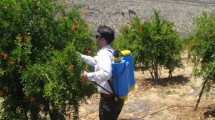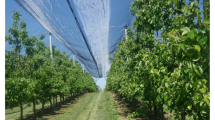Abstract
This study was conducted to investigate the growth and quality of three mint cultivars. Eau de cologne mint showed the best growth in terms of plant height, number of leaves, and fresh weight. Among quality traits, the chlorophyll content was highest in eau de cologne mint, whereas the vitamin C content was highest in pineapple mint. The nitrate, phosphate, and essential oil contents were higher in eau de cologne mint but the contents of the major essential oil constituents, L-limonene and L-menthone, were higher in apple and pineapple mint. The total yields of all three cultivars gradually increased with increasing harvesting period. The essential oil contents of eau de cologne and pineapple mint increased with increasing harvesting period, but that of apple mint decreased. The menthol contents of essential oil increased in apple and pineapple mint at each harvesting period, and 135 days after transplanting, major changes in oil constituents were detected in apple mint. Eau de cologne mint exhibited the best growth, whereas apple mint, with only slightly poorer growth, had better essential oil constituents.
Similar content being viewed by others
Literature Cited
Alkami A, Johnson AR, Srividya N, Lange BM (2015) Multiful levels of regulation determine monoterpenoid essential oil compositional variation in the mint family. Mol Plant 8:188–191
Akdogan M, Tamer MN, Cure E, Cure MC, Koroglu BK, Delibas N (2007) Effect of spearmint (Mentha spicata Labiatae) teas on androgen levels in women with hirsutism. Phytother Res 21:444–447
Arras G. and G. E. Grella (1992) Wild thyme, Thymus capitatus, essential oil seasonal changes and antimycotic activity. J Hortic Sci 67:197–202
AOAC (1995) Vitamin C (total) in vitamin preparations. AOAC Official Methods of Analysis 2:967.22, pp 18–19
Basker D, Putievsky E (1978) Seasonal variation in the yield of herb and essential oil in some Labiatae species. J Hortic Sci 53:179–183
Baird JV ((1957 The influence of fertilizers on the production and quality of peppermint in central Washington. Agron J 49:225–230
Benoit F, Ceustermans N (1995) Horticultural aspects of ecological soilless growing methods. Acta Hortic 396:11–24
Bown D (1995) New encyclopedia of herbs & their uses. Dorling Kindersley Publishing, NY, USA
Boxer A, Back P (1993 The herb book. Hamlyn, London, UK
Brud W (1993) Blending and compounding: Where is the true essential oil, AROMA '93 Conference Proceedings, IJA, UK
Burbott AJ, Loomis WD (1967) Effects of light and temperature on the monoterpenes of peppermint. Plant physiol 42:20–28
Cataldo DA, Maroon M, Schrader LE, Youngs VL (1975) Rapid colorimetric determination of nitrate in plant tissue by nitration of salicylic acid. Commun. Soil sci Plant Anal 6:71–80
Dettmer K, Aronov PA, Hammock BD (2007) Mass spectrometrybased metabolomics. Mass Spectrom. Rev. 26:51–78
Heath HB(1981) Soruce book of flavor. Avi publishing Co. Inc, NY, USA
Jung JH (1999) Effect of solution concentration and nitrogen from on the content of internal quality of Japanese mint grown in hydroponics, J Kor Soc Hort Sci 40:341–344 (in Korean)
Kowalchick C, Hylton WH (1987) Rodde’s illustrated encyclopedia of herbs. Rodale Press, Inc. Emmaus, PA
Lange BM, Ahkami A (2013) Metabolic engineering of plant monoterpenes, sesquiterpenes and diterpenes-current status and future opportunities. Plant Biotechnol J 11:169–196
Nykaenen I (1982) The effect of cultivation conditions on the composition of basil oil. Flavour Fragrance J 4:125–128.
Ody P (1993) The complete medicinal herbal. Korling Kindersley Book, NY, USA
Park KW (2003) Herb and aroma therapy (in Korean). Korea Univ. Press, Seoul, Korea
Park KW (1996) Cultures and practices in herbs (in Korean). Korea Univ. Press, Seoul, Korea
Pelter L, Amico SWA, Gordon N, Martin C, Sandifer D, Pelter MW (2008) Analysis of peppermint leaf and spearmint leaf extracts by thin-layer chromatography. J Chem Educ 85:133–134
Ram MR, Singh R, Naqvi AA, Kumar S (1997) Effect of planting time on the yield and quality of essential oil in geranium, Pelargonium graveolens. J Hortic Sci 72:807–810
Senatore F (1996) Influence of harvesting time on yield and composition of the essential oil of thyme (Thymus pulegioides L.) growing wild in Campania (southern Italy). J Agric Food Chem 44:1327–1332
Shin KE, Park HK (1994) Changes of essential oils from Mentha piperita L. influenced by various cultivation conditions and harvesting time. Korean J Food Sci Technol 26:512–519 (in Korean)
Sönmez AY, Bilen S, Alak G, Hisar O, Yanik T, Biswas G (2015) Growth performance and antioxidant enzyme activities in rainbow trout (Oncorhynchus mykiss) juveniles fed diets supplemented with sage, mint, and thyme oils. Fish physiol Biochem 41:165–175
Starburk J (2001) Herbs for sleep and relaxation. Men’s Health 16:24–26
Suh EJ, Park KW (1999) Composition and content of essential oil in hydroponically-grown basil at different season. J Kor Soc Hort Sci 40:331–335 (in Korean)
Wang XF, Ito T (1997) Effect of NO-N in the additional nutrient solution on the growth, yield and NO3 content in spinach plant grown in hydroponics. J Jpn Soc Hortic Sci 66:313–319
Author information
Authors and Affiliations
Corresponding author
Rights and permissions
About this article
Cite this article
Baek, J.P., Park, K.W., Craker, L.E. et al. Changes in growth and quality of three mint cultivars at different harvesting periods. Hortic. Environ. Biotechnol. 57, 207–212 (2016). https://doi.org/10.1007/s13580-016-0086-9
Received:
Revised:
Accepted:
Published:
Issue Date:
DOI: https://doi.org/10.1007/s13580-016-0086-9




